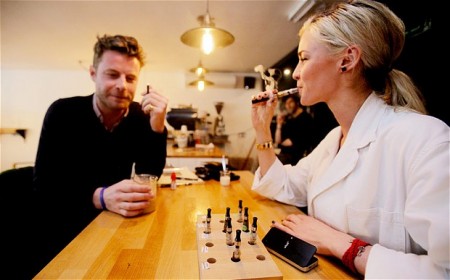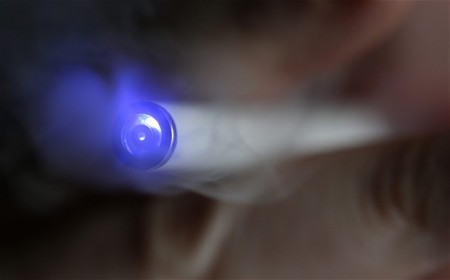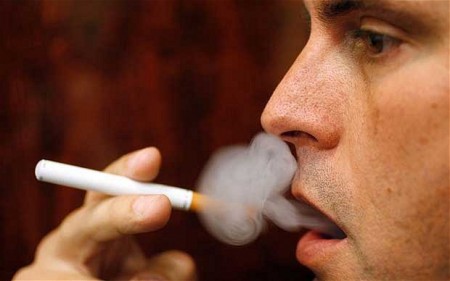Author: Sarah Knapton, Science Editor
Public health experts are sharply divided about e‑cigarettes Photo: ALAMY
Three quarters of e-cigarettes tested by Harvard scientists contained the chemical diacetyl which is known to cause lung damage.
Vapers could be at risk of developing the deadly disease ‘popcorn lung’ after scientists found a toxic chemical in 75 per cent of flavoured electronic cigarettes. Diacetyl, a chemical which is used as a butter substitute in flavours like Cotton Candy and Cupcake, has been linked to respiratory disease bronchiolitis obliterans
Although it is thought to be safe when eaten, the United States National Institute for Occupational Safety and Health has said it could be hazardous when inhaled over a long period.
It follows incidences in several factories which manufacture microwave popcorn where workers developed bronchiolitis obliterans.
Diacetyl is known to cause inflammation, scarring and constriction of the tiny airways in the lung known as bronchioles, reducing air flow. There is currently no known cure except for a lung transplantation. Researchers said ‘urgent action’ was needed to ‘evaluate this potentially widespread exposure via flavoured e-cigarettes.’
“Recognition of the hazards associated with inhaling flavouring chemicals started with ‘Popcorn Lung’ over a decade ago,” said lead author Joseph Allen, assistant professor of exposure assessment science at Harvard T.H. Chan School of Public Health.
“However, diacetyl and other related flavouring chemicals are used in many other flavours beyond butter-flavoured popcorn, including fruit flavours, alcohol flavours, and, we learned in our study, candy flavoured e-cigarettes.”
E-cigarettes use battery-powered cartridges to produce a nicotine hit via inhalable vapor without the tar and other carcinogens in inhaled tobacco smoke.
Scientists and health officials are divided over whether they are safe. Earlier this year Public Health England urged smokers to switch to vaping, saying e-cigarettes were far safer than traditional tobacco. But the World Health Organisation and scientists from the London School of Hygiene and Tropical Medicine and the University of Liverpool remain concerned about their safety.
Dr. Allen and colleagues tested 51 types of flavoured e-cigarettes and liquids sold by leading brands for the presence of diacetyl, acetoin, and 2,3-pentanedione, two related flavouring compounds which may pose a respiratory hazard in the workplace.
 Vapers enjoy different flavours at Vape Lab in Shoreditch, London Photo: JANE MINGAY FOR THE TELEGRAPH
Vapers enjoy different flavours at Vape Lab in Shoreditch, London Photo: JANE MINGAY FOR THE TELEGRAPH
Each e-cigarette was inserted into a sealed chamber attached to a lab-built device that drew air through the e-cigarette for eight seconds at a time with a resting period of 15 or 30 second between each draw. The air stream was then analyzed.
At least one of the three chemicals was detected in 47 of the 51 flavours tested. Diacetyl was detected above the laboratory limit of detection in 39 of the flavours tested. Acetoin and 2,3-pentanedione were detected in 46 and 23 and of the flavours, respectively.
“Since most of the health concerns about e-cigarettes have focused on nicotine, there is still much we do not know about e-cigarettes” said study co-author Dr David Christiani, Professor of Environmental Genetics.
“In addition to containing varying levels of the addictive substance nicotine, they also contain other cancer-causing chemicals, such as formaldehyde, and as our study shows, flavouring chemicals that can cause lung damage.”
Although the study was conducted in the US, last year Greek researchers found that diacetyl was present in 70 per cent of European brands. American brands are also available online.
The study was published in the journal Environmental Health Perspectives.
At a glance: Are e-cigarettes helpful or harmful?

- Public health officials are at odds with scientists over whether or not e-cigarettes are safe
- In August, Public Health England issued a report concluding that e-cigarettes were 95 per cent less harmful than conventional tobacco and urged Britain’s eight million smokers to start vaping.
- But health experts from the London School of Hygiene and Tropical Medicine and the University of Liverpool claim evidence used in the report was flawed, based on inconclusive evidence which was tainted by vested interests.
- Writing in the BMJ, Professor Martin McKee and Professor Simon Capewell said there was no reliable evidence to show that e-cigarettes were safe or that they did not provide a ‘gateway’ to smoking for youngsters.
- Although the PHE report was welcomed by bodies like Action on Smoking and Health (ASH) and the Royal College of Physicians of London, other leading health bodies – including the British Medical Association, the UK Faculty of Public Health, the European Commission and the World Health Organization, have expressed caution.

Nearly 80,000 people a year die of a smoking related illness and smoking costs the NHS £2 billion a year. 2.6 million people use e-cigarettes in the UK and they are now the most popular quitting aid.
This news story was resourced by the Oral Cancer Foundation, and vetted for appropriateness and accuracy.


Leave A Comment
You must be logged in to post a comment.